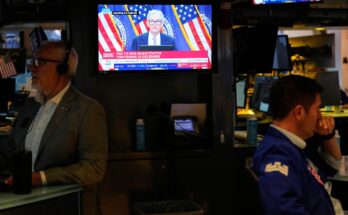The rules of the geoeconomic game have changed, and continuing like this is not good: Europe must renew itself to survive. Or as this year’s Nobel Prize winners in economics would say, Europe must encourage creative destruction, the need to constantly evolve. And this applies to both entrepreneurial activity and economic policy.
When it comes to creative destruction, the debate typically focuses on “destruction”: structural reforms, reallocating resources, avoiding keeping unprofitable companies afloat. But it is an incomplete debate: pure destruction generates nothing, only destruction. The fundamental part of the concept of creative destruction is “creative”: the redirection of destruction towards the next step, creation.
Rick Rubin, one of the most successful music producers in history, says this in his amazing book The act of creating: “Failure is the information you need to reach your destination.” But this requires two conditions: having the necessary context to be able to fail safely; and the appropriate conditions for drawing conclusions from failure and profiting from it productively.
Similarly, Silicon Valley’s “fail fast” philosophy encourages testing ideas quickly, experimenting with small, inexpensive prototypes that allow early feedback to be gathered to determine an idea’s feasibility. By quickly identifying and eliminating failing concepts, companies can save resources and focus on what works, ultimately leading to more efficient development and a greater likelihood of success.
Unfortunately, this concept of rapid failure as a path to productivity is anathema to the European economy. The top 12 cities in PitchBook’s venture capital industry ranking are in the US, UK and Asia. The first in the eurozone, Paris, is in 13th place, the second, Amsterdam, in 25th. What would explain the absence of the Eurozone in the venture capital sector? There are many reasons, including competition policy and barriers to the internal market, which limit the scope of business growth; the narrowness of the capital market, which limits financing possibilities; or work regulation, which interferes with the fail-fast culture.
Without experimentation, without failure, there is no innovation. And this relationship between experimentation and failure, and innovation, also applies to economic policy.
The best recent example is the US government’s Operation Warp Speed in 2020 to find the Covid vaccine, which saved the lives of billions of people: instead of being conservative and opting only for the strategy that had, a priori, the highest probability of success to minimize the initial cost, the US government chose to attack the problem aggressively with different strategies to maximize the probability of success, in exchange for accepting almost guaranteed losses in some initiatives. One of the fundamental principles of investment has been applied: the expected profit is positively correlated to the risk taken. And the result was a vaccine in record time, 10 times faster than normal vaccine development time: the more aggressive strategy was more effective and, without a doubt, more economically positive.
There are more examples. In 2013, China embarked on the Belt and Road Initiative, also called the “New Silk Road,” a global infrastructure investment initiative to promote trade connectivity and Chinese influence in the world economy. Criticized at the time for its ambition and high probability of failure, over time it was seen as a strategy of access to natural resources and infrastructure that significantly increased China’s autonomy. They gambled big, risked failure, and reaped significant economic and geostrategic benefits. And today they continue with the same strategy, investing in resources, accumulating reserves of critical materials and diversifying their supply networks.
In Europe, unfortunately, the concept that without experimentation and failure there is no innovation goes against nature: minimizing the risk of failure dominates while maximizing the expectation of success. European inertia is always aimed at regulation to minimize risks. European competition policy has prioritized the interest of consumers – who benefit from lower prices – over the incentive to innovate, which requires the expectation of being able to benefit from the innovative effort. The lack of trust between European partners always leads to inaction and a strategy aimed at minimizing possible losses – which is best reflected in the refusal to mutualize risks and in the quagmire of fiscal rules – and not to maximize the possible benefit of economic policy decisions. The recommendations of the reports by Enrico Letta and Mario Draghi remain unimplemented, the necessary Eurobonds are reduced to a minimum and the European budget proposal for 2028 reduces, rather than increases, the available resources.
The recent initiative of the Spanish government, the European Competitiveness Laboratory, is a breath of fresh air to try to break this negative dynamic against innovation in economic policy. This is a proposal to break the rigidity of European decision-making unanimity, so that coalitions of European countries can be created to carry out economic policy initiatives, learn from experience – “fail fast” – and therefore be able to extend the improved initiatives to the whole of Europe.
It’s the way to go. In this new geopolitical context, resilience takes on an increasing value: the objective of economic policy is no longer to maximize growth, but rather growth adequate for geopolitical risk. And this requires investment of resources and risk of losses. For example: Reducing dependence on China in the supply of rare earths requires a large investment in extraction and processing that will require a combination of public investment, subsidies and price guarantees – well designed, of course – that incentivize private investment. It’s a situation analogous to Operation Warp Speed, where an aggressive, multidimensional strategy will, in the long run, be much more effective. Likewise, the concept of a sovereign investment fund should be reconsidered: it must not only be used to invest commercial surpluses, the key is that the expected return, from a geostrategic point of view, is higher than the cost of financing.
The trade war, the control of rare earths, the doubts about the credibility of NATO’s defense commitment, have meant a rude awakening for Europe, and have highlighted the harmful consequences of its culture of austerity: no investment, no return. The paradox of risk in all its dimensions: Europe’s excessive conservatism has increased the fragility of its economy. As a speaker recently stated at a conference in Shanghai, Europe has no strategic autonomy, and it doesn’t have it because it doesn’t want it. Let’s learn from this lack of improvement. If Europe wants to promote creative destruction, improve its growth and resilience, and achieve strategic autonomy, it must invest, experiment, and risk failure from time to time along the way. If you want, you can.
In X @angelubide



